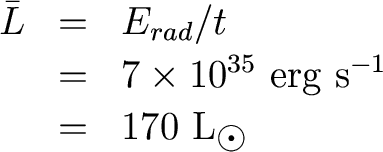Answer: Remember that the energy radiated during a collapse to size R is


Remember this luminosity is from gravitational contraction alone - no nuclear reactions!
So what part of the H-R diagram does this protostar live in?
We can calculate both the luminosity
of the collapsing cloud, as well as its temperature
(once it becomes optically thick). So we can place it on
the H-R diagram. Since its structure is changing, T and L change, so its
position on the H-R diagram changes. We can calculate how it moves on the
H-R diagram -- this is called an evolutionary
track.
Question: what is the luminosity of a 1 Msun protostar which has collapsed to R=500 Rsun, if most of the energy is liberated in the last 100 years of the collapse?At the point where the protostar has reached adiabatic contraction (that is the gravitational energy heats the star), the collapse slows considerably -- it has achieved quasi-static equilibrium.Answer: Remember that the energy radiated during a collapse to size R is
And if that energy is given off in the last 100 years of the collapse, the luminosity is Remember this luminosity is from gravitational contraction alone - no nuclear reactions!
So what part of the H-R diagram does this protostar live in?
| Low mass stars contract
and drop in luminosity, until the interior opacity drops and the energy
comes flooding out, resulting in an increase in surface temperature and
luminosity.
High mass stars have low opacity
to begin with (because of high temperatures) and simply heat up as the
contract.
Contraction Times:
0.5 Msun: 150 million years |
 |